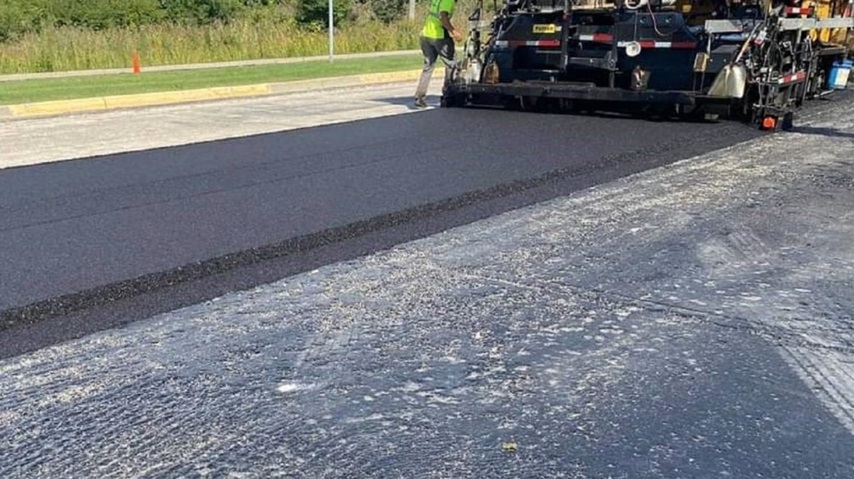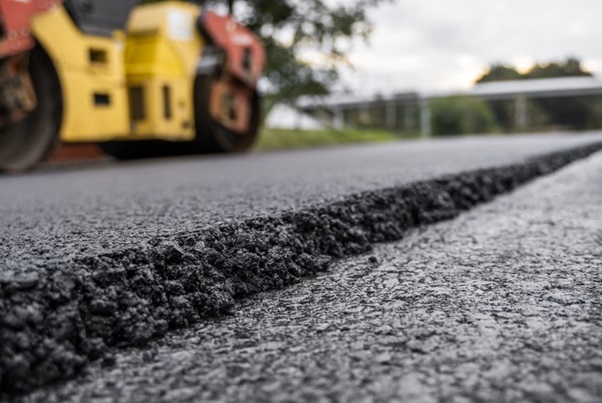Warm Mix Asphalt (WMA) is a type of asphalt mix produced at significantly lower temperatures than traditional hot mix asphalt. The production at lower temperature is achieved by using special chemical additives that reduce the viscosity of the binder, making it easier to handle and lay. WMA maintains the same performance and durability as hot mix asphalt, but it is produced at temperatures ranging from 100°C to 140°C, compared to the standard 150°C to 180°C for hot mix asphalt. The reduced production temperature makes WMA easier to handle and compact, enhancing its suitability for a wide range of road construction and maintenance projects.
Warm Mix Asphalt (WMA) is used across various applications:
- New Road Construction: WMA is applied in the construction of new highways, roads, and streets.
- Pavement Rehabilitation: It is used for resurfacing and repairing existing roadways.
- Airport Runways and Taxiways: WMA is used in the construction and maintenance of airport runways and taxiways.
- Cold Weather Paving: WMA is suitable for paving in colder climates, allowing for year-round construction.
- Urban and Rural Road Maintenance: It is used for both urban and rural road repairs and maintenance.
Advantages of Warm Mix Asphalt (WMA)
- Less prone to temperature fluctuations during mixing.
- Faster paving and compaction speeds up construction timelines.
- Provides smoother and durable pavement with fewer surface defects.
- Easier handling in colder climates due to its workability at lower temperatures.
- Reduces disruption to traffic by allowing faster curing and road reopening.
- Lower environmental impact through reduced emissions during application.
- Ideal for thin surface layers without compromising quality.
- Decreases the risk of segregation in the mixture during placement.
- Extended workability time allows for more flexibility during application.
- Complies with environmental standards by minimizing fumes and VOCs.
- Durable surface for high-traffic roads ensuring long-lasting performance.
- Improved surface friction enhances road safety.
- Faster project completion due to quicker compaction and curing times.
- Ideal for urban road repairs with minimal disruption to city traffic.
- Reduces oxidation of binder, maintaining long-term performance.

Different methods used for producing Warm Mix Asphalt (WMA)
1. Foamed Asphalt Method
The foamed asphalt method involves injecting a small amount of water into a hot asphalt binder, which causes the binder to expand and foam when exposed to heat. This foaming process reduces the viscosity of the binder, allowing it to mix more easily with aggregates at lower temperatures, typically between 100°C to 140°C. The foamed binder cools down quickly and becomes workable, facilitating the mixing and compaction of the asphalt mixture at a significantly lower temperature compared to traditional hot mix asphalt. This method helps in reducing energy consumption during production and also lowers the amount of greenhouse gases emitted during the asphalt production process. The foam also enhances the binder’s adhesion to aggregates, leading to improved durability and workability.
2. Chemical Additives Method
In the chemical additives method, special waxes, resins, or other additives are introduced into the asphalt binder to reduce its viscosity. These chemical additives are specifically designed to lower the binder’s temperature sensitivity, making it more fluid and easier to mix with aggregates at lower temperatures. The additives typically allow mixing and compaction temperatures to be reduced by 20°C to 40°C compared to traditional hot mix asphalt. This method is often used in conjunction with other technologies to further improve the workability and performance of the final product. The reduced temperature requirement leads to energy savings, improved worker safety due to reduced fumes, and a smaller carbon footprint during production. Additionally, chemical additives help maintain the durability and flexibility of the final mix, ensuring long-lasting pavement performance.
3. Asphalt Emulsion Method
The asphalt emulsion method involves using water-based asphalt emulsions as a binder instead of conventional hot asphalt binder. In this method, asphalt binder is emulsified with water and an emulsifying agent to create a stable mixture that can be used in place of hot binder. The asphalt emulsion remains fluid at lower temperatures, allowing it to be mixed with aggregates at a much cooler temperature, typically between 50°C and 100°C. The water content in the emulsion evaporates during the curing process, leaving behind a strong and durable asphalt layer. The primary advantages of using asphalt emulsion are its lower energy consumption and reduced emissions during production, as well as the ability to be stored and transported more easily than hot asphalt. This method is particularly useful in areas where the ambient temperature is lower, and it offers a more environmentally friendly alternative to traditional hot mix asphalt.
4. Synthetic Additives Method
Synthetic additives method involves mixing a synthetic additive into the asphalt binder to lower its viscosity at reduced temperatures. This technique allows asphalt to be mixed and compacted at temperatures 20°C to 40°C lower than those required for traditional hot mix asphalt. The additive, often a non-ionic surfactant, helps maintain the binder’s performance while enabling asphalt production at lower temperatures. This results in reduced energy consumption, less fuel usage, and a decrease in greenhouse gas emissions during asphalt production. The method also enhances the workability of the mixture, making it easier to handle and compact, while ensuring the long-term durability and performance of the pavement.
5. WMA with Foaming Technology (Superpave) Method
In the WMA with foaming technology method, a specific type of foaming technology (often used in the Superpave mix design) is utilized to produce warm mix asphalt. This method works by injecting a small amount of water into the binder, which results in foaming and expansion when exposed to heat. The foaming process lowers the viscosity of the asphalt, allowing for easier mixing and compaction at lower temperatures, typically between 100°C and 140°C. This technology is commonly used in conjunction with the Superpave mix design, which is known for its high-performance standards in asphalt paving. The reduced temperature in this method leads to significant energy savings, reduces emissions, and allows for better working conditions on the job site. Additionally, the foamed binder maintains its durability, ensuring the asphalt mixture can withstand high traffic loads and extreme weather conditions.

Why the demand for Warm Mix Asphalt (WMA) ?
The demand for Warm Mix Asphalt (WMA) has increased due to its ease of use and flexibility in application. WMA is applied at lower temperatures, making it easier to handle, spread, and compact, especially in cooler conditions. This allows contractors to work over extended hours and in conditions that would be challenging for traditional Hot Mix Asphalt (HMA), ensuring timely project completion.
For contractors, WMA also offers operational benefits like reduced fuel consumption and less equipment downtime due to lower production temperatures. Additionally, the ability to incorporate higher recycled asphalt pavement (RAP) content helps lower material costs while supporting sustainability goals, making WMA a cost-effective and eco-friendly choice.
Conclusion
Warm Mix Asphalt (WMA) offers a sustainable solution that enhances both environmental and operational efficiency in road construction. As the industry continues to embrace greener practices, WMA represents a promising step towards more eco-friendly infrastructure development.


